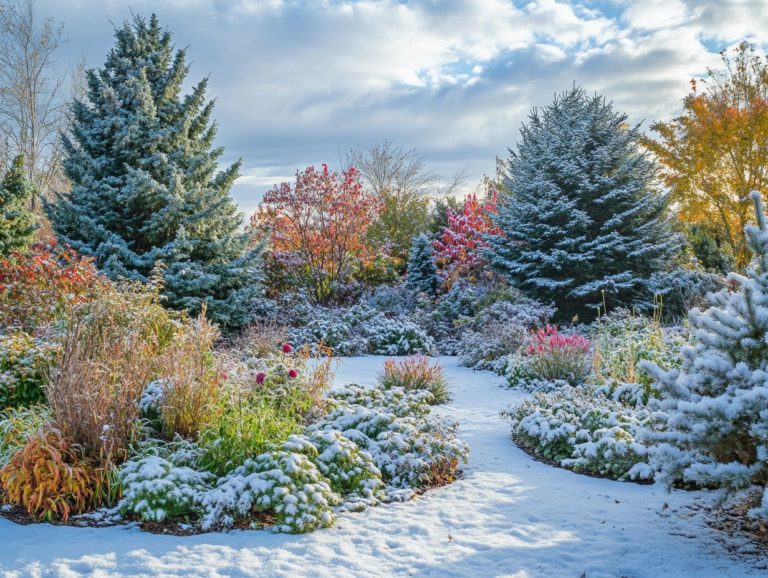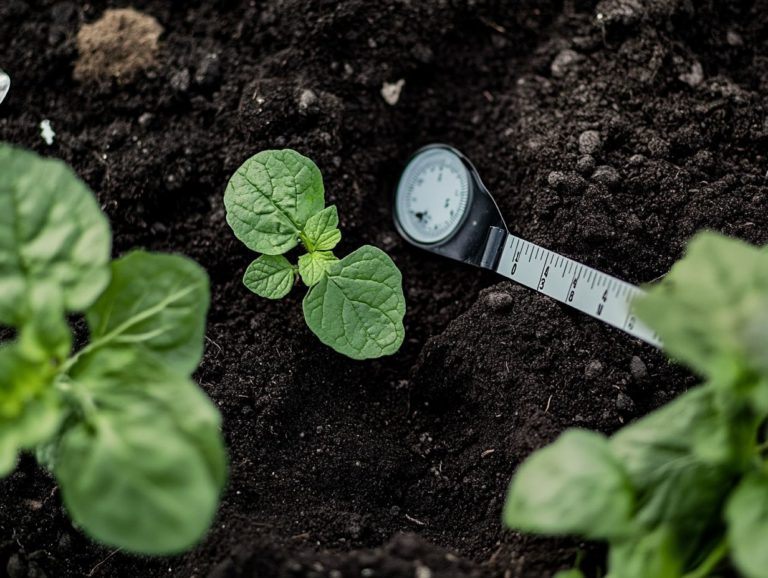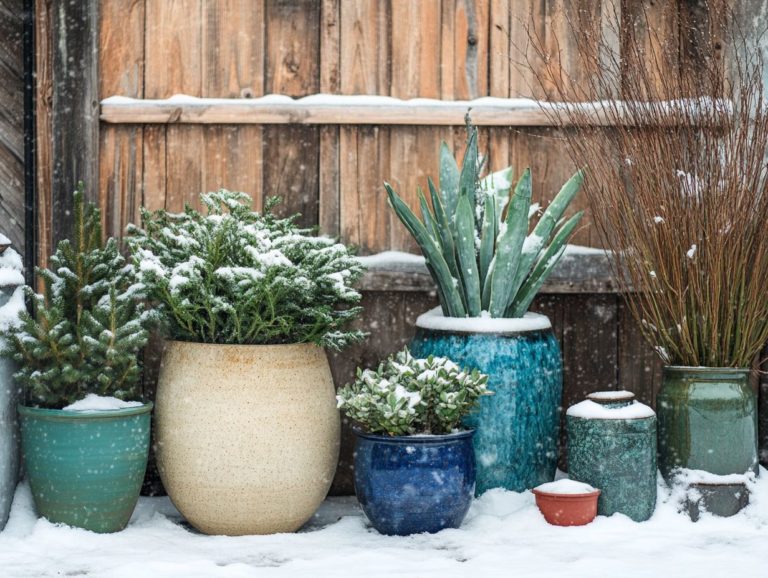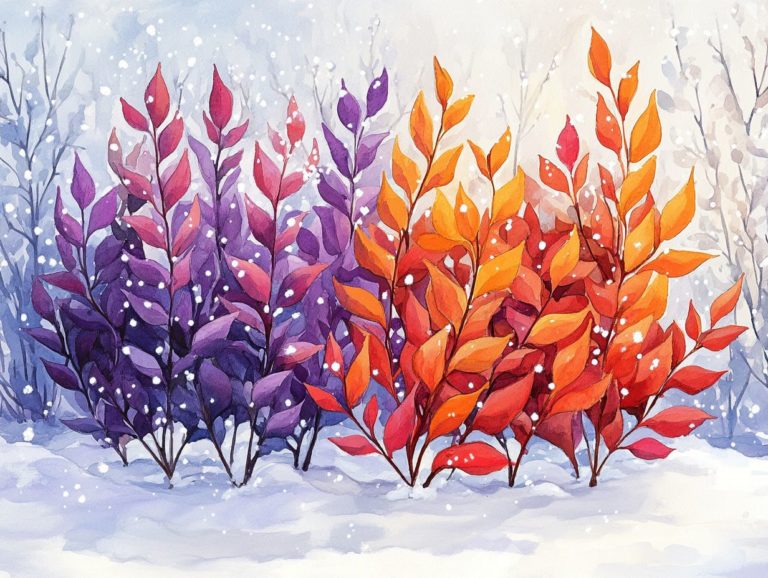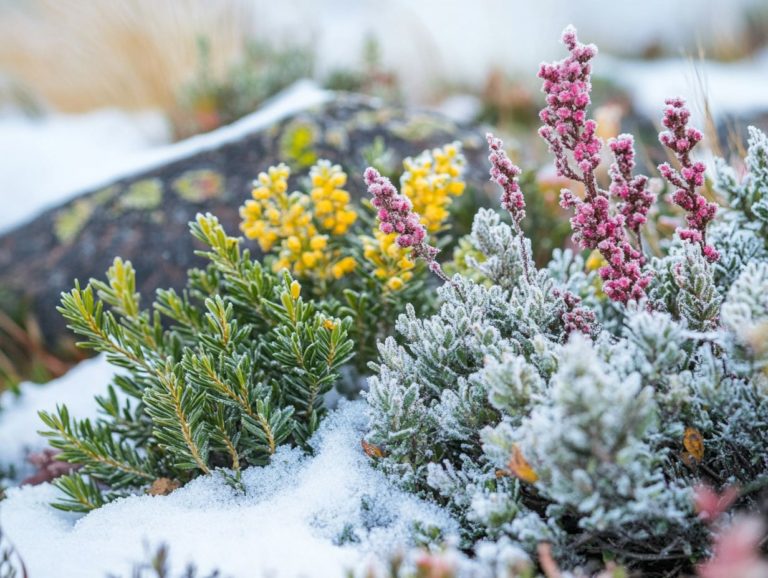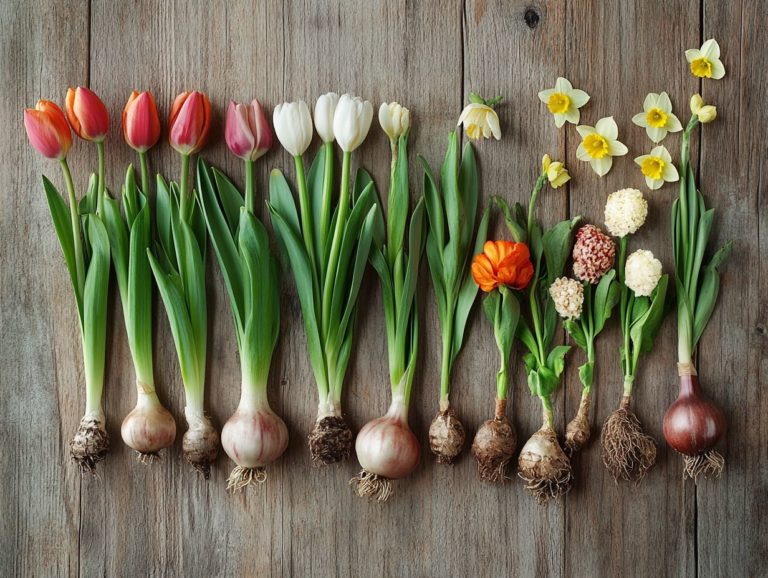Flowers That Withstand Cold Weather
When winter s chill envelops the landscape, it s easy to perceive gardens as bare and lifeless. However, there s a hidden beauty waiting for your discovery in the form of cold-weather flowers that infuse vibrant color and interest during even the frostiest months. From cheerful pansies to resilient winter jasmine, these hardy blooms bring not only visual appeal but also remarkable resilience against the elements.
Dive into the world of cold-weather flowers and explore their unique care tips along with the myriad benefits they offer to your garden. Uncover the secrets to transforming your winter landscape into a flourishing oasis that defies the seasonal gloom.
Contents
- Key Takeaways:
- 1. Pansies
- 2. Snapdragons
- 3. Hellebores
- 4. Winter Jasmine
- 5. Winter Aconite
- 6. Snowdrops
- 7. Primroses
- 8. Witch Hazel
- 9. Lenten Rose
- 10. Cyclamen
- 11. Christmas Rose
- 12. Winterberry Holly
- 13. English Ivy
- 14. Skimmia
- 15. Winter Pansy
- How to Care for Cold-Weather Flowers?
- Frequently Asked Questions
- Wondering which flowers can brave the frost? Here are some hardy options:
- How do I prepare my garden for cold weather?
- What are the benefits of planting cold-weather flowers?
- Can I still plant cold-weather flowers in the fall?
- Do I need to water my cold-weather flowers in winter?
- What should I do with my cold-weather flowers after winter?
Key Takeaways:
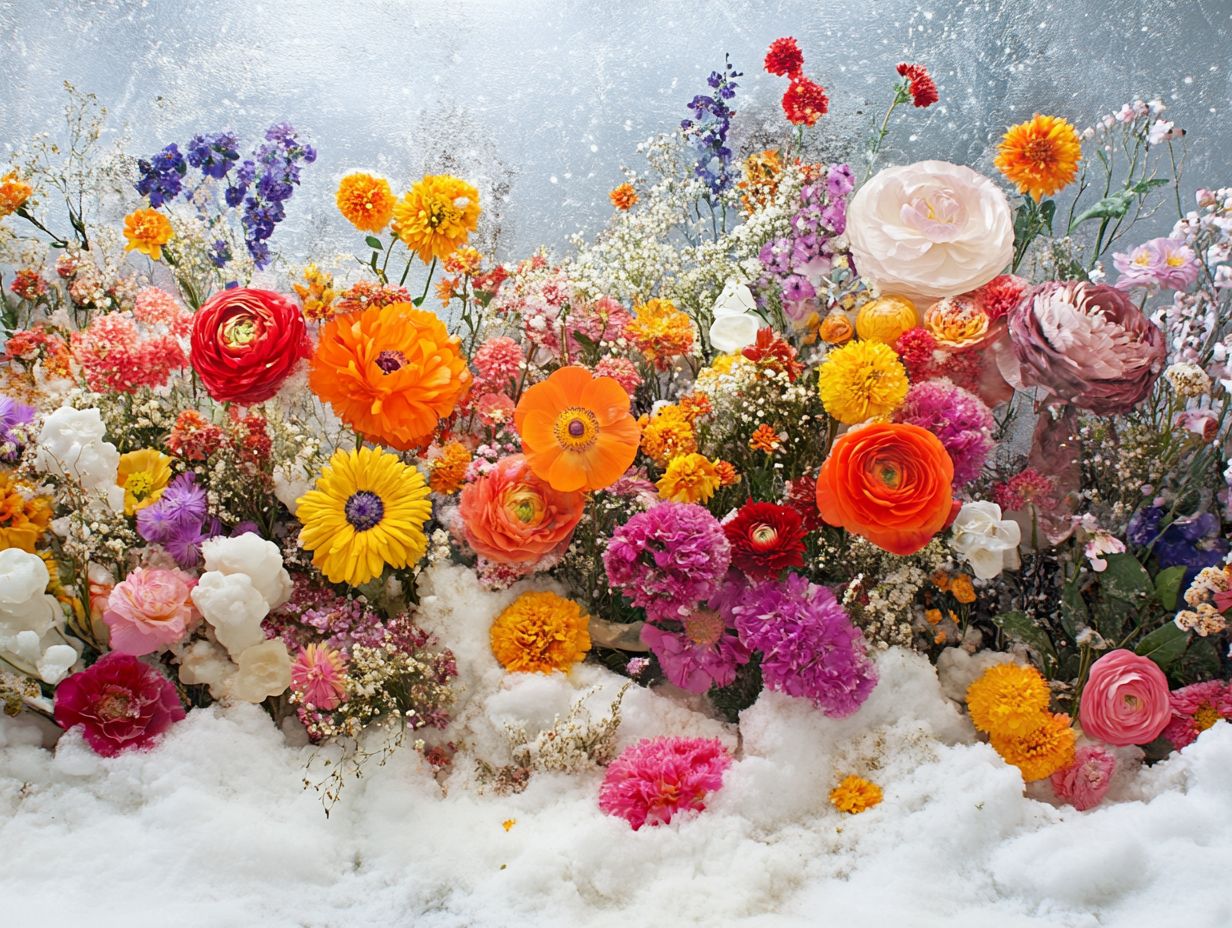
- Pansies, snapdragons, and hellebores are hardy flowers that can withstand cold weather conditions.
- Winter jasmine, winter aconite, and snowdrops are also resilient and can add color to a winter garden.
- Proper care and placement, such as planting in well-drained soil and providing enough sunlight, can help cold-weather flowers thrive and enhance your garden’s beauty.
1. Pansies
Pansies are a vibrant addition to your garden or container, celebrated for their ability to flourish in cooler temperatures. This makes them the perfect choice for early spring blooms and stunning arrangements that infuse color and charm into your outdoor spaces.
These delightful flowers come in a dazzling array of colors, from bold purples and yellows to soft pastels. This variety allows you to craft visually striking displays that reflect your personal style. Pansies thrive in well-drained soil and prefer a sunny or partially shaded location, making them versatile enough for various planting styles.
They re especially suited for container gardening, brightening up patios or balconies with a splash of color wherever it’s needed. Their cold hardiness means they can brave the night chill, ensuring that you can enjoy their beauty well into the cooler months!
2. Snapdragons
Snapdragons are the enchanting cool flowers you ll want to showcase in your garden. Their distinctive floriferous spikes flourish beautifully in the cool spring weather, making them a favorite among plant lovers.
These delightful plants are available in a stunning array of colors, from soft pastels to bold shades like deep red and bright yellow. They effortlessly enhance any landscape with their lively palette. Heights vary widely; while some charming dwarf varieties stand at a petite six inches, others can tower up to three feet, offering you versatility whether in flower beds or container gardens.
Snapdragons attract pollinators, including butterflies and hummingbirds, enriching the biodiversity of your garden. For snapdragons to thrive, plant them in well-drained soil in a spot that enjoys full sun to partial shade.
Keep them happy with regular watering, especially during dry spells, and remember to deadhead those spent blooms. This will not only keep your plants healthy but also encourage a continuous display of flowers throughout their growing season!
3. Hellebores
Hellebores are truly stunning cold-weather flowers that grace your garden with their blooms in early spring. Often referred to as Lenten roses, these remarkable plants are prized for their resilience in colder climates, effortlessly enhancing your garden’s aesthetics.
Showcasing a mesmerizing array of colors, from deep purples to soft pastels, hellebores are a dazzling addition that elevates any landscape. Their unique nodding flowers emerge just as winter begins to wane, providing a delightful splash of color when most other plants are still in hibernation.
Thriving in shaded or partially shaded areas, they are the perfect solution for those tricky spots in your garden where sunlight is scarce. With their early blooms, hellebores make excellent companions for other seasonal favorites, adding depth and texture to your flower arrangements and welcoming the arrival of spring with grace and style.
Start planting cold-weather flowers today to enjoy a vibrant garden all year round!
4. Winter Jasmine
Winter Jasmine is a delightful cold-hardy flower that bursts into life with bright yellow blooms. It adds a vibrant touch to your winter flower beds while filling your garden with a lovely fragrance during the colder months.
Its sprawling growth habit makes it an exceptional choice for cascading over walls or trellises. This creates a stunning backdrop for other seasonal blooms. To ensure it performs at its best, plant it in soil that allows water to flow through easily, though it s impressively adaptable to a variety of soil textures be it clay or sandy mixes.
Regular pruning is essential to maintaining its shape and encouraging a fuller display of those captivating flowers, making it a worthwhile addition to your garden design. This charming plant not only brightens up the dreary winter landscape but also attracts an array of pollinators, enriching the ecological balance of your outdoor space.
5. Winter Aconite
Winter Aconite is a standout in the garden and one of the first to bloom, heralding spring with its cheerful yellow flowers. These resilient beauties thrive even in the chill of winter, making them a perfect choice for container gardening.
For optimal growth, provide them with well-draining, moist soil rich in organic matter; this balance is key to preventing the tubers from rotting. When planted in partially shaded spots or dappled sunlight, they thrive and brighten your garden, creating a stunning display against the lingering remnants of winter.
Pair Winter Aconite with other cold-season annuals like pansies or early-flowering tulips. Together, they ll weave a vibrant tapestry of colors that brightens your garden as temperatures rise, crafting an enchanting early spring landscape that s sure to impress.
6. Snowdrops
Snowdrops are exquisite, cold-hardy flowers that bravely push through the snow, embodying hope and renewal with their delicate white blooms. They thrive in moist soil during the chilly early days of spring, bringing a sense of freshness to your garden.
These charming plants prefer shaded or partially shaded spots, often gracing woodlands, meadows, and other areas where they bask in dappled sunlight. Ensure the soil is well-draining yet consistently moist, as they flourish in environments that closely resemble their natural habitat.
Pairing snowdrops with other early spring flowers like crocuses and anemones enhances the visual appeal of your garden and creates a vibrant tapestry that celebrates the transition from winter to spring. Their compatibility with cold-tolerant annuals allows them to cozy up alongside pansies or violas, resulting in a beautifully diverse landscape that adds a splash of color, even when the temperatures are still cool.
7. Primroses
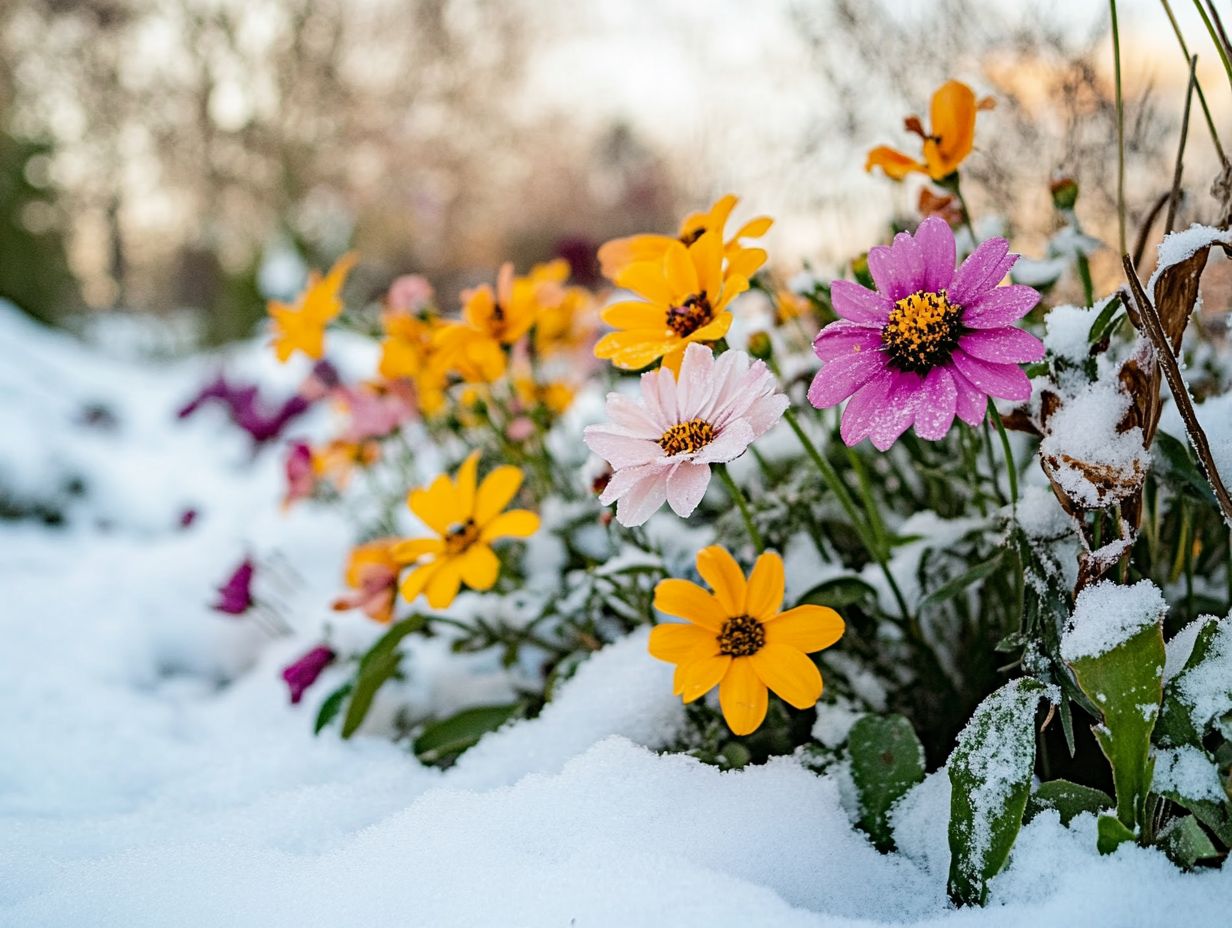
Primroses are delightful cool flowers that present a stunning array of colors, blooming profusely in early spring. Use them to enhance both garden beds and captivating flower arrangements, effortlessly brightening up any space.
You ll appreciate the variety among these charming blooms, including the ever-popular Primula vulgaris, famous for its cheerful yellow flowers, and the striking Primula auricula, which showcases vibrant hues like purple, red, and blue.
Thriving in well-drained soil and partial shade, primroses flourish in rich, organic environments that retain moisture without becoming overly soggy. Their early blooms provide essential nectar for pollinators, such as bees and butterflies, playing a vital role in sustaining local ecosystems.
Incorporate primroses into your container gardening or flower beds by planting them alongside early-season bloomers like daffodils or tulips. This creates a dynamically colorful palette while ensuring they have ample space to spread out and create an enchanting display.
Start planting for early spring blooms now!
8. Witch Hazel
Witch Hazel is a delightful addition to your garden, with fragrant flowers blooming in winter. It brings elegance and visual interest to your landscape, even when other plants are dormant.
Different species, like Hamamelis virginiana and Hamamelis x intermedia, bloom at various times in winter. Some may surprise you with golden-yellow flowers as early as January.
These hardy shrubs thrive in cold climates and are practical for landscaping. Their spidery flowers contrast beautifully with early spring bulbs like crocuses and snowdrops.
Planting witch hazel alongside evergreens elevates your garden s appeal all year long. It s a fantastic choice for creating a vibrant outdoor space!
9. Lenten Rose
Lenten Rose, or hellebore, is truly a gem in the garden. Its stunning blooms brighten your landscape in early spring, showcasing its ability to thrive as a cold-tolerant perennial while requiring minimal care.
This remarkable plant thrives in shaded areas, making it perfect for woodland gardens or cozy spots beneath taller plants. Its leathery, evergreen foliage offers a charming backdrop after the flowers fade.
Lenten Rose flourishes in well-drained soil enriched with organic material, striking a perfect balance of moisture retention without becoming waterlogged. Incorporating Lenten Rose alongside other flowering plants enhances the visual appeal and ensures a continuous sequence of blooms, bridging the gap between the winter chill and the full bloom of spring.
10. Cyclamen
Cyclamen are enchanting cold-hardy flowers, celebrated for their distinctive heart-shaped leaves and vibrant blooms. They effortlessly brighten your container gardens and floral arrangements during the chill of winter and freshness of spring.
These charming plants thrive in partial shade and well-draining soil, making them ideal for infusing color into both indoor and outdoor spaces. Look for a spot that enjoys gentle morning sunlight while being sheltered from harsh afternoon rays.
If you’re adding them to container gardens, opt for well-aerated potting mixes enriched with organic matter for healthy growth. In flower beds, interplant them with seasonal favorites to create stunning focal points, ensuring your garden transitions beautifully from winter to spring.
11. Christmas Rose
Christmas Rose, or Helleborus niger, is a remarkable plant that introduces stunning varietals to your cold-weather garden. Its exquisite white flowers often make their debut as early as December, transforming your winter landscape into a cherished oasis.
This perennial beauty thrives in shaded areas, offering a bold contrast to delicate early blooms that announce spring’s arrival. Its leathery, deep-green foliage brings vibrancy, even when snow blankets the ground, crafting an enchanting winter scene.
Beyond its striking appearance, the Christmas Rose nurtures pollinators during the colder months. It attracts early bees and beneficial insects searching for sustenance, making it vital for your garden’s ecosystem. This adaptability and ecological contribution enhance its visual appeal and establish it as an essential asset for sustainable winter gardens.
12. Winterberry Holly
Winterberry Holly is a type of holly that loses its leaves in winter, bringing a burst of vibrant red berries to your garden during the cold months.
It serves as a captivating focal point in flower beds and is a great choice for gardening in cold weather, attracting local wildlife.
These resilient shrubs flourish in various soil types, especially in wet or acidic conditions. They also provide vital food sources for birds like cardinals and blue jays during the cold months.
The bright berries create a striking contrast against a snowy backdrop.
You can easily weave this species into your garden designs, using its height and structure to create visually engaging layers. By planting them in groups or alongside evergreens, the vibrant display of berries elevates the overall winter landscape, ensuring your garden remains stunning even when other plants have faded.
13. English Ivy
English Ivy is an amazing climbing plant that will transform your garden! It stands out for its incredible adaptability, making it perfect for both container gardening and colder climates.
With a variety of unique cultivars, it can elevate any garden design. This hardy perennial thrives in various environments, effortlessly flourishing in both shaded and sunny areas.
You ll appreciate its trailing vines, which cascade elegantly over pots. Its climbing ability on trellises or walls creates a lush, green backdrop that enhances your outdoor space.
Caring for this enchanting plant requires consistent moisture and well-draining soil. Occasional pruning keeps it looking its best.
When paired with colorful annuals or complementary foliage plants, it truly shines in container arrangements or as an alluring ground cover, making it a beloved choice for various garden aesthetics.
14. Skimmia
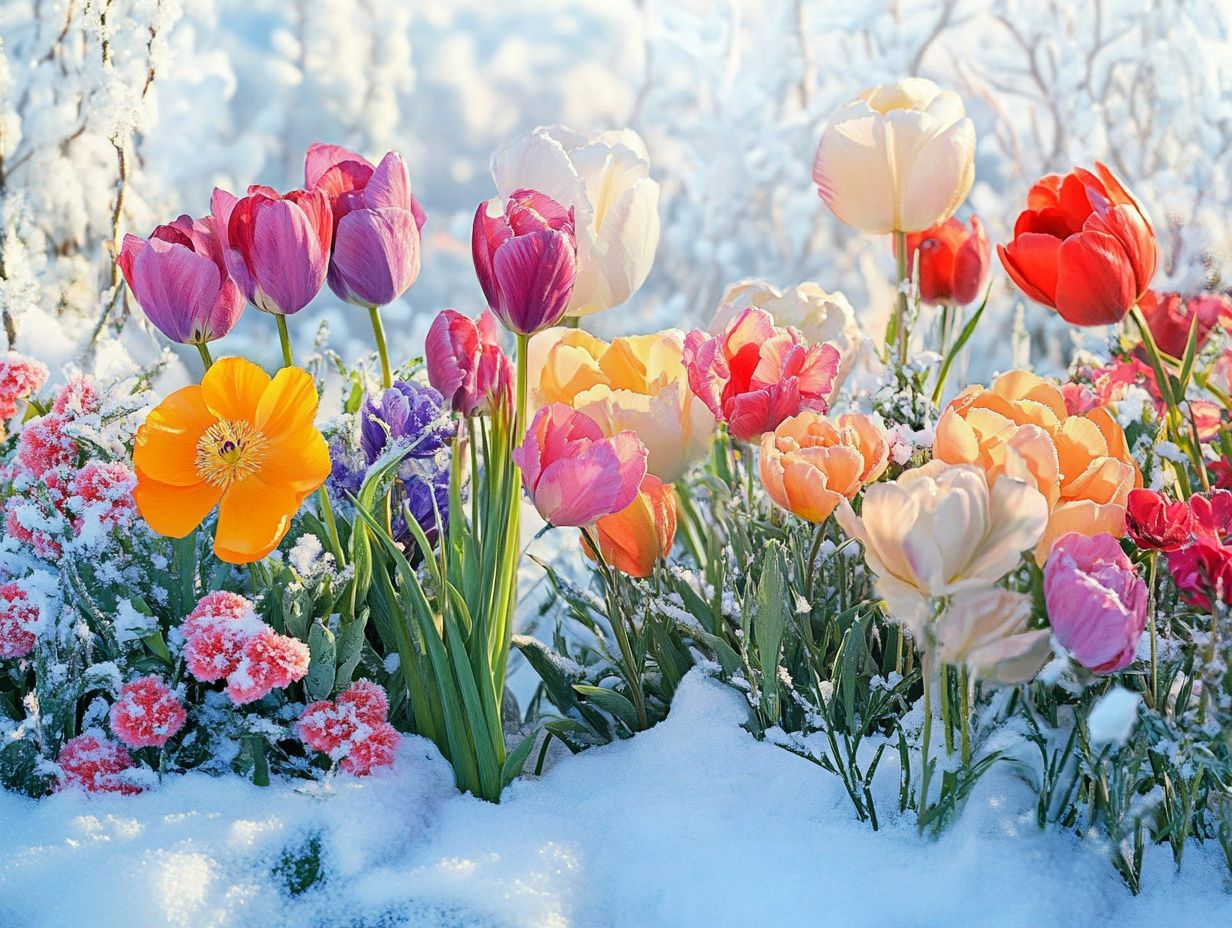
Skimmia is a delightful shrub celebrated for its fragrant flowers that bloom from late winter to early spring. This makes it ideal for cold-hardy flower arrangements and container plants in chillier climates.
This versatile plant flourishes in partially shaded areas, making it an exceptional option for woodland gardens or shady corners where many other flowering plants tend to falter.
Skimmia easily adapts to various soil textures but thrives best in well-draining, loamy soil enriched with organic matter. Regular watering and a layer of mulch help maintain moisture levels and encourage robust growth.
With its evergreen foliage and exquisite blooms, this shrub elevates the visual appeal of your spring gardens. It also fills the air with a delicate fragrance, drawing in pollinators and enriching your overall garden experience.
15. Winter Pansy
The Winter Pansy is a resilient flower that flourishes in cooler temperatures. It infuses your flower beds and container gardens with vibrant colors and a touch of elegance throughout the winter and early spring months.
Don t miss out on these vibrant blooms that can brighten even the dreariest winter days! They thrive in well-draining soil and require moderate watering.
It’s crucial to keep the soil consistently moist but not soggy, as overwatering can lead to root rot.
Positioning them in a location that receives partial to full sunlight ensures optimal growth and flowering. Their versatility allows them to blend seamlessly into various garden settings, from formal landscapes to charming cottage gardens.
They play a significant role in attracting pollinators, making them an excellent choice for eco-conscious gardening.
How to Care for Cold-Weather Flowers?
Caring for cold-weather flowers is vital to keep your garden vibrant and healthy! These plants require specific attention throughout their growth cycles, especially when learning how to choose the right plants for cold weather and when working with cold-hardy flowers and annuals thriving in cooler temperatures.
They rely not just on adequate watering but also on a proper amount of nutrients for healthy growth. The texture of your soil plays a vital role in moisture retention; loamy soils strike the perfect balance, preventing both waterlogging and dryness. Regularly checking moisture levels is essential to ensure these flowers receive consistent hydration, especially during unexpected frosty nights.
Employ protective measures, such as frost blankets during cold snaps, to safeguard delicate blooms from potential damage. Implement effective pest management strategies to enhance their resilience, keeping unwanted visitors at bay and allowing your beautiful plants to thrive throughout the colder months.
What Are the Benefits of Planting Cold-Weather Flowers?
Planting cold-weather flowers brings a wealth of benefits. You ll enjoy early blooms that infuse your garden with vibrant color during chillier months while providing crucial resources for pollinators, enhancing the health of the entire ecosystem.
These resilient plants not only elevate the visual appeal of your garden in winter but also support local biodiversity. When you choose options like snowdrops or hellebores, you beautify your space and create inviting habitats for early pollinators such as bees and butterflies.
By offering nectar and pollen when food sources are scarce, these hardy flowers aid in the survival of essential species. This mindful cultivation allows you to extend the blooming season, providing resources for wildlife while fostering a thriving garden.
How Can Cold-Weather Flowers Enhance Your Garden?
Cold-weather flowers can truly elevate your garden, bringing in vibrant colors that thrive in the chill. For inspiration, explore winter blooms: flowers for cold climates that provide striking visuals and intriguing textures to your flower arrangements and overall garden design.
By thoughtfully selecting flowers for a cold-climate border, you ensure that your landscape remains inviting and lively, even as temperatures dip. Consider the cheerful pansy, showcasing a delightful range of hues, or the delicate hellebore, celebrated for its unique, cup-shaped flowers.
Both offer stunning contrasts against the starkness of winter. The evergreen foliage of plants like winter heath adds continuity and enhances the spatial dynamics of your garden. Mix these blooms with early spring bulbs such as snowdrops to create a layered effect, transforming your outdoor space into a vibrant scene throughout the seasons.
What Are the Different Types of Cold-Weather Flowers?
You’ll discover a delightful array of cold-weather flowers, including unique varieties that enhance your flower beds and stand resilient against the chill. For tips on choosing the best options, learn how to select cold-hardy flowers. Vibrant pansies catch the eye, boasting a stunning spectrum of colors and the ability to flower even when temperatures plunge below freezing.
Then there are hellebores, often lovingly dubbed Christmas roses, lending an air of elegance with their delicate petals and evergreen foliage. Ornamental kale makes for another striking option, offering captivating visual interest and stunning color patterns that shift as the temperature changes.
Care for these flowers varies; some thrive in well-drained soil, while others prefer the respite of partial shade. When you combine these varieties thoughtfully in your flower beds, you create a breathtaking tapestry of color and texture, transforming any cold-weather landscape into a warm and inviting oasis.
What Are the Best Locations to Plant Cold-Weather Flowers?
Choosing the right locations to plant your cold-weather flowers is essential for their success. Look for areas with well-drained, moist soil and the right amount of sunlight exposure. For the best results, consider the top 10 perennials for cold-weather gardens, as these factors will enable your resilient blooms to flourish, even under challenging conditions.
To truly optimize their potential, plant them in places that get at least six hours of sunlight each day. This is vital for encouraging robust growth and vibrant colors.
Selecting locations with good airflow can help prevent diseases that thrive in stagnant conditions.
Pay attention to the soil texture. Sandy or loamy soils typically promote better drainage than heavy clays, which can lead to root rot.
Make sure to check how much moisture your soil holds. Your flowers should neither be too dry nor waterlogged, as both extremes can stunt their development.
With a little care and consideration, you ll create an ideal environment for your cold-weather blooms to thrive.
Watch this video to learn how to care for your cold-weather flowers.
Frequently Asked Questions

Wondering which flowers can brave the frost? Here are some hardy options:
Some examples of flowers that can withstand cold weather include pansies, snapdragons, cyclamen, hellebores, and winter jasmine.
How do I prepare my garden for cold weather?
To prepare your garden for cold weather, add a layer of mulch (a protective covering) around your flowers to insulate the soil and protect the roots. Cover your flowers with a frost cloth or blanket during particularly cold nights for extra protection.
What are the benefits of planting cold-weather flowers?
Planting flowers for late blooming in cold climates can help extend the blooming season in your garden. They provide beautiful color and life during the colder months. These flowers are hardy and can survive harsh conditions, making them a great addition to any garden.
Can I still plant cold-weather flowers in the fall?
Yes! You can still plant flowers that can withstand cold weather in the fall. In fact, some of these flowers, such as mums and pansies, are best planted in the fall for a beautiful display in winter and early spring.
Do I need to water my cold-weather flowers in winter?
It depends on the amount of rainfall and snowfall in your area. If there isn t enough natural moisture, you may need to water your flowers occasionally. Just be careful not to overwater, as excess moisture can cause root rot.
What should I do with my cold-weather flowers after winter?
After winter, trim off any dead or damaged parts of the flowers. Give them a light fertilizing to help them recover from the colder months. Make sure to remove any mulch or frost covers once temperatures start to rise. Your flowers should continue to bloom and thrive throughout the spring and summer.
Don’t miss out on planting these resilient flowers this fall for a stunning winter display! Start enhancing your garden’s beauty now!

